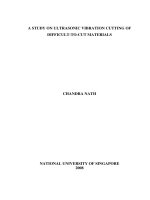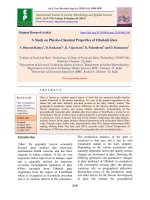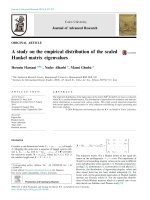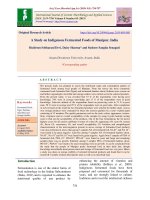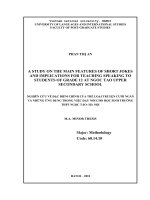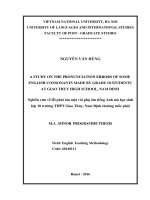A study on ultrasonic vibration cutting of difficult to cut materials
Bạn đang xem bản rút gọn của tài liệu. Xem và tải ngay bản đầy đủ của tài liệu tại đây (9.74 MB, 210 trang )
A STUDY ON ULTRASONIC VIBRATION CUTTING OF
DIFFICULT-TO-CUT MATERIALS
CHANDRA NATH
NATIONAL UNIVERSITY OF SINGAPORE
2008
A STUDY ON ULTRASONIC VIBRATION CUTTING OF
DIFFICULT-TO-CUT MATERIALS
CHANDRA NATH
(B.Sc Engg. (Hons.), BUET)
A THESIS SUBMITTED
FOR THE DEGREE OF DOCTOR OF PHILOSOPHY
DEPARTMENT OF MECHANICAL ENGINEERING
NATIONAL UNIVERSITY OF SINGAPORE
2008
i
To my
Mother,
Honorable teacher M. A. Bashar and
Beloved wife
ii
Acknowledgements
First I express my deepest and heartfelt gratitude to my supervisor Professor Dr.
Mustafizur Rahman for his continuous supervision, valuable time, untiring efforts,
strong guidance, immense and continuous supports and inspirations for completion
the entire research work. He has always provided me a global view of research,
background knowledge, constructive criticisms and invaluable timely feedbacks and
suggestions to finish my research successfully. I sincerely appreciate his pronounced
individualities, positive attitudes, humanistic and warm personal approaches.
I sincerely thank Mr. K. S. Neo of Advanced Manufacturing Laboratory (AML) for
his continuous supports during the tests, time and patience in criticizing the
experimental results and helping to solve machine and instruments related problems. I
also express my deepest thanks to the lab officer Mr. Tan Choon Huat, the technicians
Mr. Nelson Yeo Eng Huat, Lim Soon Cheong, Wong Chian Loong, Simon from AML
and Mr. Au Siew Kong, Lee Chiang Soon from Workshop-2 for their time, supports,
and patience in operating the machine and instruments for the experimental tests.
Special thanks go to my labmates and friends: Subramanyam, Hesamoddin, Indraneel,
Tanveer, Rubina, Sadiq, Wahab, Lingling, Sharon, Shaon, Lingling, Sazid, Pervej,
Haiyan, Muntakim, Tarik, Kim Tho, Asma, Wang Xue, Woon, Jianjian and friends
around for their supports and inspirations at various stages of this project. Sincere
thanks go to my mom, wife, family members for their continuous supports and
encouragements, which help me to finish this work successfully within due time.
I also thank National University of Singapore (NUS) for providing me a research
scholarship and the excellent and advanced facilities for this research work.
iii
Contents
Acknowledgements………………………… …………………………ii
Contents iii
Summary ix
List of Tables xi
List of Figures xiii
Nomenclature xix
Abbreviations xxi
Chapter 1: Introduction…………………………………………… …1
1.1 Background 1
1.2 Ultrasonic Vibration Cutting (UVC) Method 3
1.2.1 Conventional UVC (CUVC) Method 4
1.2.2 Ultrasonic Elliptical Vibration Cutting (UEVC) Method 5
1.3 Comparison between the CC, CUVC and UEVC Methods 6
1.4 Motivation, Scope and Main Objectives 7
1.5 Organization of This Dissertation 8
Chapter 2: Literature Review 11
2.1 Review on the CUVC method 11
2.1.1 Surface Roughness, Roundness, and Waviness 14
2.1.2 Cutting Force, Cutting System Stability and Tool Wear 15
iv
2.1.3 Effect of Parameters in CUVC Performances 17
2.1.4 Tool-Workpiece Combinations in the CUVC Method 19
2.2 Review on the UEVC Method 21
2.2.1 Surface Roughness and Roundness 21
2.2.2 Cutting Force, Cutting System Stability and Tool Wear 24
2.2.3 Effect of Parameters on UEVC Performances 25
2.2.4 Tool-Workpiece Combinations in the UEVC Method 26
2.2.5 Tool Wear Behavior in the UEVC Method 27
2.2.6 Critical DOC and Maximum Thickness of Material Cut in UEVC 28
2.3 Concluding Remarks 30
Chapter 3: Experimental Details 32
3.1 Introduction 32
3.2 Experimental Details for the CUVC Tests 32
3.2.1 Lathe Machine: Okuma LH-35N 32
3.2.2 CUVC Device: Sonic Impulse SB-150 33
3.2.3 Workpiece Material 34
3.2.4 Tool Inserts 35
3.2.5 Measuring Instruments 35
3.2.6 Experimental Procedures 37
3.3 Experimental Details for the UEVC tests 38
3.3.1 Toshiba Ultraprecision Machine 38
3.3.2 UEVC Device: EL-50∑ 38
3.3.3 Workpiece Material 39
3.3.4 Tool Inserts 40
v
3.3.5 Measuring Instruments 41
3.3.6 Experimental Procedures 43
Chapter 4: Study on Machining Parameters in CUVC method……48
4.1 Introduction 48
4.2 Theory 50
4.2.1 Study of the CUVC Mechanism 50
4.2.2 The Effect of Tool Vibration Frequency 53
4.2.3 The Effect of Tool Vibration Amplitude 54
4.2.4 The Effect of Workpiece Cutting Speed 56
4.3 Verification of Theoretical Studies 58
4.4 Cutting Conditions 59
4.5 Results and Discussions 60
4.5.1 Effect of Cutting Speed on Cutting Force and on Tool Wear 60
4.5.2 Effect of Feed Rate on Cutting Force and on Tool Wear 66
4.5.3 Tool Wear vs. Cutting Time 68
4.5.4 Analysis of Chip Formation 70
4.5.5 Effect of Cutting Speed and Feed Rate on Surface Roughness 72
4.6 Comparative Analysis between the CC and CUVC Methods 75
4.7 Concluding Remarks 76
Chapter 5: UEVC of Sintered Tungsten Carbide 78
5.1 Introduction 78
5.2 The UEVC Principle 79
5.3 Cutting Conditions 83
vi
5.4 Results and Discussions 84
5.4.1 Effect of Cutting Parameters on Force Components 84
5.4.2 Effect of Cutting Parameters on Tool Flank Wear 89
5.4.3 Effect of Cutting Parameters on Surface Roughness 91
5.4.4 Parameters for Improving Cutting Performance: a Case Study …… 94
5.4.5 Performance Comparison: the UEVC and CC Methods 97
5.5 Effect of Tool Geometry in UEVC 101
5.5.1 Effects of Nose Radius: the Theoretical Phenomenon 103
5.5.2 Effect of Nose Radius on Force Components 104
5.5.3 Effect of Nose Radius on Tool Wear 106
5.5.4 Effect of Nose Radius on Surface Roughness…………………………108
5.6 Concluding Remarks 111
Chapter 6: PCD Tool Wear Mechanism in UEVC Method 114
6.1 Introduction 114
6.2 Theoretical Aspects: Effect of Speed Ratio 115
6.3 Cutting Conditions for Tool Wear Experiments 118
6.4 Results and Discussions 119
6.4.1 Cutting Force and Tool Flank Wear Analyses 119
6.4.2 Tool Wear Progression and Mechanism 124
6.4.3 Chip Analysis 129
6.4.4 EDX Analyses of Tool Nose and Chips 132
6.4.5 Surface Roughness Analysis 132
6.5 Concluding Remarks 137
vii
Chapter 7: Modeling of Maximum Thickness of Cut in UEVC 140
7.1 Introduction 140
7.2 Theoretical Analyses 141
7.2.1 Effect of DOC on Finished Surface 142
7.2.2 Condition to Obtain a Reduced TOC
m
145
7.2.3 Maximum TOC (TOC
m
) at a
s
R
within the
scr
R
146
7.2.4 Maximum TOC (
m
TOC ) at the
scr
R (
cm
TOC ) 148
7.2.5 Maximum and Minimum TOCs at a
s
R beyond the
scr
R 148
7.2.6 Maximum TOC Ratio (
mr
TOC
) at Different
s
R 149
7.2.7 Effect of
s
R on Cycle-Overlap )(
31
xx
−
,
m
TOC and
mr
TOC 149
7.2.8 Determination of the Critical Speed Ratio,
scr
R 151
7.3 Effects of Machining Parameters 153
7.3.1 Effect of Cutting Speed 153
7.3.2 Effect of Tool Vibration Frequency 154
7.3.3 Effect of Tangential Vibration Amplitude 155
7.3.4 Effect of Thrust Vibration Amplitude 156
7.3.5 Selection Criteria of Parameters for Ductile Mode Cutting 158
7.3.6 Increasing the Cutting speed for Higher Machining Rate at R
scr
158
7.4 Experimental Verification of the Model 160
7.5 Concluding Remarks 166
Chapter 8: Conclusions and Recommendations 168
8.1 Main Contributions 168
8.2 Recommendations for Future Work 170
viii
References 172
List of Publications 181
Appendix A 183
Appendix B 185
Appendix C……………………………….….……………… 187
ix
Summary
High quality machining of difficult-to-cut materials such as Ni- and Ti-based alloys,
tungsten carbide, glass, ceramics, hardened steels etc. is very important in current
advanced technological applications, e.g. aerospace and turbine engine parts, precise
die and molds, cutting tools, optical and electronic devices, etc. However,
conventional cutting (CC) technique to machine these materials with quality finishing
is cumbersome due to poor machinability. Nonconventional machining processes such
as grinding, EDM, etc. are also sometimes impractical for machining these materials
due to either one or more of the following reasons: high machining cost, inability to
produce complex shapes, very low machining rate etc.
Recently, ultrasonic vibration cutting (UVC) technique is found to be a promising
technology for high quality machining of those intractable materials. In this study,
two types of UVC: conventional UVC (CUVC) and ultrasonic elliptical vibration
cutting (UEVC) techniques are studied and applied respectively to Inconel 718 and to
sintered WC (~15% Co). The aims and findings are described as follows.
In the first phase, the effects of the relevant machining parameters in CUVC method
are theoretically investigated. Then the effects of machining parameters on CUVC
performances are experimentally evaluated, when cutting Inconel 718 using CBN
tools. The CUVC and the CC results are also compared under the same cutting
conditions applied. Theoretical study reveals that the CUVC mechanism is directly
influenced by three parameters: tool vibration frequency and amplitude and cutting
speed. It is established that tool-workpiece contact ratio (TWCR) plays a key role in
x
the CUVC process where the increase in both the tool vibration parameters and the
decrease in cutting speed reduce the TWCR, which in turn reduces both the cutting
force and tool wear. The theoretical findings are substantiated by the experimental
results. It is also observed that, in hard cutting, the CUVC method improves surface
finish and prolongs tool life as compared to the CC method but at lower cutting speed.
In
the second phase, the UEVC method is applied to sintered WC using polycrystalline
diamond (PCD) tools. The effects of cutting parameters and tool geometry on UEVC
performances are investigated. The UEVC results are also compared with the CC
results at a set of cutting conditions. The PCD tool wear mechanisms under the UEVC
method are also analyzed. It is found that the UEVC method performs better in all
aspects over the CC method. Average surface roughness, R
a
of 0.0101 µm is achieved
at optimized 4 µm DOC and 0.6 mm nose radius. The study suggests that PCD tools
can be applied for ultraprecision machining of sintered WC under the UEVC method.
In the last phase, theoretical relations are developed for predicting the maximum
thickness of cut (TOC
m
) at a given DOC in each UEVC cycle with respect to the
relevant machining parameters. It is found that four machining parameters: workpiece
cutting speed, tool vibration frequency and tangential and thrust directional vibration
amplitudes have direct influence on the TOC
m
. A reduced TOC
m
can be obtained if the
speed ratio is at or within a critical value 0.12837. Also, when the TOC
m
is kept lower
than the DOC
cr
, ductile finishing of brittle materials can be achieved. The established
relationships are substantiated by experimental investigations when machining the
sintered WC. Findings in this study confirm that ductile cutting of brittle materials can
be achieved at a higher DOC by controlling those parameters in the UEVC technique.
xi
List of Tables
Table 1.1 Performances comparison between the CC, CUVC and UEVC
methods………………………………………………………………
6
Table 2.1 Previous studies on the CUVC method including the experimental
conditions……………………………………………………………
12
Table 2.2 Previous studies on the UEVC method including the experimental
conditions……………………………………………………………
22
Table 3.1 Chemical compositions (%) of Inconel 718…………………………
34
Table 3.2 Physical and mechanical properties (at RT) of workpiece Inconel
718…………………………………………………………………
34
Table 3.3 Properties of the CBN tool inserts…………………………………
35
Table 3.4 Specifications of the CBN tool inserts………………………………
35
Table 3.5 Major chemical composition of sintered WC used…………………. 40
Table 3.6 Physical and mechanical properties of sintered WC………………
40
Table 3.7 Physical and mechanical properties of PCD tool used in UEVC tests
41
Table 3.8 Operation types for different categories of the UEVC experiments
43
Table 4.1 Experimental conditions for the CUVC and the corresponding CC
tests…………………………………………………………………
60
Table 5.1 Cutting conditions for observing the effect of cutting parameters in
UEVC method: (Operation type: Turning; coolant type: mist)……
84
Table 5.2 Tool geometry and vibration parameters (fixed)…………………….
84
Table 5.3 Tool conditions for geometry tests in UEVC method: (Operation
type: facing; coolant type: air)
102
Table 6.1 Cutting conditions for PCD tool wear experiments under UEVC
method: (Operation type: Turning; coolant type: mist)……………
118
Table 6.2 Tool geometry and vibration parameters for PCD tool wear
experiments under UEVC (Undeformed chip thickness*,
max
d =
0.675 µm)……………………………………………………………
119
xii
Table 7.1 Determination of the critical speed ratio using iteration method with
varying the crucial parameters (^ Condition:
ba
p
>
, b = 1.5 µm. a
is in µm, f is in kHz and
c
v is in m/min)……………………………
152
Table 7.2
Control of the
m
TOC and
mr
TOC based on the R
s
and
)(
31
xx −
by
controlling the related three parameters:
c
v , f and a . (^ at b <
p
a ,
* Ref. Figs. 7.5-7.7).…………………………………………………
156
Table 7.3 Cutting conditions for verification of the proposed model
(6.0≈
cr
DOC µm)………………………………………… ………
161
xiii
List of Figures
Figure 1.1 Principle vibration directions of ultrasonic vibration cutting…….
5
Figure 1.2 Elliptical vibration cutting process……………………………….
6
Figure 2.1 Experimental work displacement with tool rake angle = 0
o
and
tool clearance angle = 10
o
(a) CC method and (b) CUVC method.
(Xiao et al., 2002)………………………………………………
16
Figure 2.2 Influence of three cutting methods on shape error………………
23
Figure 2.3 (a) Principal and thrust components of cutting force due to the
UEVC method (Shamoto and Moriwaki, 1994); (b) Thrust
cutting force measured in three cutting methods (Ma et al., 2004).
25
Figure 2.4 Height of burrs in three cutting methods (Ma et al., 2005)……….
25
Figure 3.1 Photograph of OKUMA LH35-N CNC lathe at Workshop -2 .….
33
Figure 3.2 (a) SB-150 vibrator device containing PZTs and tool inserts and
(b) cross- section of flexural oscillation system and vibration
displacement of (a)………………………………………………
33
Figure 3.3 Illustrations of the CUVC test set up (turning operation)………
37
Figure 3.4 Photograph of the Toshiba ULG-100 H
3
Ultraprecision machine
in AML……………………………………………………………
38
Figure 3.5 Photographs of the EL-50∑ device: (a) the vibrator and (b) the
vibration controller (top) and the amplifiers (bottom)……………
39
Figure 3.6 Photograph of the SEM (JEOL JSM-5500) associated with an
EDX machine……………………………………………………
42
Figure 3.7 Photograph of the Taylor-Hobson surface profilometer connected
with a computer monitor………………………………………….
43
Figure 3.8 Illustration of the UEVC experimental set up (turning operation).
44
Figure 3.9 Photograph of the UEVC experimental set up (turning operation).
45
Figure 3.10 Photograph of the UEVC experimental set up (facing operation)
47
Figure 4.1 Schematic of ultrasonic vibration cutting………………………
50
Figure 4.2 Pulse cutting state in the UVC method…………………………
50
xiv
Figure 4.3 CUVC process: (a) Tool displacement and resultant cutting force
for two different tool vibration frequencies (Subscripts: 1, 2 are
for 20 kHz, 35 kHz, respectively), (b) Relation between TWCR
and tool vibration frequency, f……………………………………
53
Figure 4.4 CUVC process: (a) Tool displacement and resultant cutting force
for two different tool vibration amplitudes (Subscripts: 1, 2 are
for 10 µm, 25 µm, respectively), (b) Relation between TWCR
and tool vibration amplitude, a…………………………………
55
Figure 4.5 CUVC process: (a) Tool displacement and pulsating cutting force
against time at f = 20 kHz and a = 15 µm. (Subscripts: 1, 2 are
for low and high cutting speed, respectively), (b) Relation
between TWCR and workpiece cutting speed,
c
v
……………….
57
Figure 4.6 Cutting force components vs. cutting speed for both cutting
processes at a feed rate of (a) 0.05 mm/rev; (b) 0.1 mm/rev……
61
Figure 4.7 Tool flank wear (V
B
) vs. cutting speed for both cutting processes
after 10 min of cutting at a feed rate of (a) 0.05 mm/rev and (b)
0.1 mm/rev………………………………………………………
62
Figure 4.8 The SEM photographs of tool wear characteristics at different
cutting conditions. (a)-(d): CT method; (e)-(h): UVC method…
64
Figure 4.9 Effect of feed rate in both the cutting methods at a cutting speed
of 10 m/min: (a) cutting force components, (b) tool flank wear
width V
B
after 10 minutes of cutting……………………………
67
Figure 4.10 Tool flank wear width (V
B
) against cutting time for both cutting
methods at a feed rate of 0.05 mm/rev……………………………
68
Figure 4.11 Tool flank wear width (V
B
) against cutting time for both cutting
methods at a feed rate of 0.1 mm/rev……………………………
69
Figure 4.12 SEM photographs of the chips produced at different cutting
conditions by both the cutting methods. CT method: (a)
10m/min, 0.05 mm/rev; (b) rectangular region of (a); (c) 10
m/min, 0.1 mm/rev and CUVC method: (d) 10 m/min, 0.05
mm/rev; (e) rectangular region of (d); and (f) 10 m/min, 0.1
mm/rev……………………………………………………………
71
Figure 4.13 Average surface roughness values, R
a
against cutting speeds in
both the cutting methods after 10 minutes of cutting at a feed rate
of: (a) 0.05 mm/rev and (b) 0.1 mm/rev………………………….
72
Figure 4.14 Average surface roughness values, R
a
against feed rates in both
the cutting methods after 10 minutes of cutting at a cutting speed
of 10 m/min……………………………………………………….
73
xv
Figure 4.15 Comparative analysis of cutting performances between the CT
and the CUVC methods at selected cutting speed of 10 m/min at
a feed rate of (a) 0.05 mm/rev and (b) 0.1 mm/rev……………….
75
Figure 5.1 (a) The schematic of UEVC principle; (b) Ultrasonic elliptical
vibrator with stacked PZTs and its vibration modes……………
80
Figure 5.2 (a) Four different cutting states of an UEVC cycle, (b) the
corresponding cutting force states (
o
t = Beginning of elliptical
cycle,
b
t = beginning of cutting,
r
t = beginning of reverse motion,
e
t = End of cutting)………………………………………………
81
Figure 5.3 Effect of DOC on the force components against cutting time at a
feed rate of 20 µm/rev and cutting speed of 7.54 m/min: a) thrust
component; b) tangential component; and c) axial component…
86
Figure 5.4 Effect of feed rate on the force components against cutting time
at a DOC of 4 µm and cutting speed of 7.54 m/min: a) thrust
component; b) tangential component and c) axial component……
87
Figure 5.5 Effect of cutting speed on the force components against cutting
time at a DOC of 4 µm and feed rate of 5 µm/rev: a) thrust
component; b) tangential component and c) axial component……
88
Figure 5.6 Effect of cutting parameters on tool flank wear: a) effect of DOC
(feed rate: 20 µm/rev and cutting speed: 7.54 m/min); b) effect of
feed rate (DOC: 4 µm and cutting speed: 7.54 m/min); c) effect
of cutting speed (DOC: 4 µm and feed rate: 5 µm/rev)…………
90
Figure 5.7 SEM photographs of PCD tool flank wear at different cutting
conditions in the UEVC tests……………………………………
91
Figure 5.8 Effect of cutting parameters on surface roughness: a) effect of
DOC (feed rate: 20 µm/rev and cutting speed: 7.54 m/min); b)
effect of feed rate (DOC: 4 µm and cutting speed: 7.54 m/min);
c) effect of cutting speed (DOC: 4 µm and feed rate: 5 µm/rev)…
92
Figure 5.9 Nomarski photographs of machined surface of WC at different
cutting conditions in the UEVC tests……………………………
93
Figure 5.10 Performance comparison between case 1 and case 2 in the UEVC
method: (case 1: 5 µm/rev feed rate and 0.086 speed ratio (test
no. 10); case 2: 1.67 µm/rev feed rate and 0.257 speed ratio (test
no. 11))……………………………………………………………
95
Figure 5.11 SEM photographs of flank faces of PCD tools used in case 1 and
case 2: (a) case 1: 5 µm/rev feed rate and 0.086 speed ratio (test
no. 10); (b) case 2: 1.67 µm/rev feed rate and 0.257 speed ratio
(test no. 11)……………………………………………………….
95
xvi
Figure 5.12 Surface profiles (T-H) of machined surfaces in case 1 and case 2:
(a) case 1: 5 µm/rev feed rate and 0.086 speed ratio (test no. 10);
(b) case 2: 1.67 µm/rev feed rate and 0.257 speed ratio (test
no.11)……………………………………………………………
96
Figure 5.13 Nomarski photographs (100x) of machined surfaces of WC in
case 1 and case 2: (a) case 1: 5 µm/rev feed rate and 0.086 speed
ratio (test no. 10); (b) case 2: 1.67 µm/rev feed rate and 0.257
speed ratio (test no. 11)…………………………………………
97
Figure 5.14 Comparison of cutting performance between the UEVC and CC
methods at 4 µm DOC, 5 µm /rev feed rate and 0.086 speed ratio:
(a) comparison of force components; (b) overall cutting
performances……………………………………………………
98
Figure 5.15 Cutting performance with the CC method: (a) surface profile (T-
H) and (b) Nomarski photograph (100x). Conditions: 4 µm DOC,
5 µm /rev feed rate and 0.086 speed ratio………………………
100
Figure 5.16 Comparison of T-H profiles (close-up) between (a) the UEVC
and (b) the CT method at DOC 4 µm, feed rate 5 µm/rev and
cutting speed 2.51 m/min…………………………………………
100
Fig. 5.17 Effect of tool nose radius on cutting force components…………
103
Fig. 5.18 Variation of the cutting force components against different tool
nose radiuses in the UEVC technique…………………………….
105
Fig. 5.19 Tool flank wear width at various tool nose radiuses in the UEVC
method…………………………………………………………….
106
Fig. 5.20 SEM photographs of PCD tool flank at various tool nose radiuses
in the UEVC method……………………………………………
107
Fig. 5.21 Averages and maximum surface roughness values at various tool
nose radiuses……………………………………………………
108
Fig. 5.22 T-H profiles of the machined surfaces at different tool nose
radiuses……………………………………………………………
109
Fig. 5.23 Nomarski photographs of machined surfaces at various
tool nose radiuses…………………………………………………
110
Figure 6.1 Effect of speed ratio on tool-workpiece relative motion in UEVC
method at a = b = 2 µm, f = 38.87 kHz: (a) R
s
= 0.064 (v
c
= 1.885
m/min); (b) R
s
= 0.086 (v
c
= 2.513 m/min); (c) R
s
= 0.107 (v
c
=
3.142 m/min) and (d) R
s
= 0.129 (v
c
= 3.770 m/min)…………….
116
Figure 6.2 Effect of machining time on force components at different speed
ratios in the UEVC process: (a) Thrust force F
y
, (b) Tangential
xvii
force, F
x
and (c) Axial force, F
z
(DOC 4 µm and feed rate 5
µm/rev)……………………………………………………………
120
Figure 6.3 Effect of machining time on tool flank wear at different speed
ratios in UEVC process (DOC 4 µm and feed rate 5 µm/rev)……
121
Figure 6.4 Nomarski photographs of a fresh PCD tool: (a) flank face and (b)
rake face…………………………………………………………
123
Figure 6.5 Nomarski photographs (100x) of a tool flank ((a)-(d)) and rake
((e)-(f)) face at different cutting time (R
s
: 0.064, DOC: 4 µm and
feed rate: 5 µm/rev)……………………………………………….
124
Figure 6.6 Nomarski photographs (100x) of a tool flank ((a)-(f)) and rake
((g)-(j)) face at different cutting time (R
s
: 0.107, DOC: 4 µm and
feed rate: 5 µm/rev)……………………………………………….
126
Figure 6.7 Nomarski photographs (100x) of a tool flank ((a)-(f)) and rake
((g)-(h)) face at different cutting time (R
s
: 0.129, DOC: 4 µm
and feed rate: 5 µm/rev)…………………………………………
127
Figure 6.8 SEM photographs of flank faces of PCD tools after 60 minutes of
cutting at speed ratios: (a) 0.086; (b) 0.107 and (c) 0.129………
128
Figure 6.9 SEM Photographs of produced chips after 20 sec and 15 minutes
of cutting time at different speed ratios (DOC: 4 µm and feed
rate: 5 µm/rev)…………………………………………………….
129
Figure 6.10 SEM and EDX of the flank face: (a) rectangular region of Fig.
7(b); (b) EDX of (a); (c)-(d) quantitative analysis of (b)…………
132
Figure 6.11 EDX analysis of generated chips at R
s
= 0.129 after 15 minutes
of cutting: (a) EDX spectrums of rectangular region in Fig.
6.9(g); (b) quantitative analysis of (a)…………………………….
133
Figure 6.12 Effect of cutting time on finished surface at different speed ratio.
(DOC: 4 µm and feed rate: 5 µm/rev) ……………………………
135
Figure 6.13 Nomarski photographs of the machined surface at different speed
ratios. (DOC 4 µm and feed rate 5 µm/rev)………………………
136
Figure 7.1 Effect of DOC on the finished surface generating in the UEVC
method when 0)(
31
>
−
xx (
p
a : nominal DOC)…………………
143
Figure 7.2 Reduction of nominal DOC due to controlled speed ratio in the
UEVC method: a) at critical; and b) within critical conditions
145
Figure 7.3
Effect of speed ratio on cycle-overlap, )(
31
xx
−
at various
tangential (or cutting) directional tool vibration amplitudes, a ….
150
xviii
Figure 7.4 Effect of speed ratio on (a) the maximum thickness of cut,
m
TOC ; and (b) the maximum TOC ratio,
mr
TOC for different
nominal DOCs. (Condition: ba
p
> , where b = 1.5 µm) ………
151
Figure 7.5
Effect of cutting speed, v
c
on the
m
TOC in the UEVC method:
(a)
c
v = 2.26 m/min (R
s
= 0.10); (b)
c
v = 2.9037 m/min, (R
s
=
R
scr
= 0.12837); (c)
c
v = 3.39 m/min (R
s
= 0.15); f = 40 kHz, a =
1.5 µm, b = 1.5 µm……………………………… ………………
154
Figure 7.6
Effect of tool vibration frequency, f on the
m
TOC in the UEVC
method: (a)
f = 51.2 kHz (R
s
= 0.1), (b) f = 40 kHz (R
s
= R
scr
=
0.12837) and (c)
f = 34.13 kHz (
s
R = 0.15); a = 1.5 µm, b = 1.5
µm,
c
v = 2.9037 m/min………………………… …………….
155
Figure 7.7 Effect of tangential vibration amplitude, a of the tool on the
m
TOC in the UEVC method: (a) a = 2 µm and v
c
= 3.02 m/min
(
s
R = 0.1); (b) a = 1.5 µm and v
c
= 2.9037 m/min (
s
R = R
scr
=
0.12837); (c) a = 1 µm, and
c
v = 2.26 m/min (
s
R = 0.15). b = 1.5
µm, f = 40 kHz……………………………………………………
155
Figure 7.8 Effect of thrust vibration amplitude, b of the tool on the: (a)
m
TOC ; and (b)
mr
TOC at different speed ratios (Conditions:
p
a
= 4 µm and a
p
> b).……………………………………………….
157
Figure 7.9
Effect of thrust vibration amplitude, b of the tool on the
m
TOC at
the
scr
R (= 0.12837) in the UEVC method: (a) b = 1 µm; (b) b =
1.5 µm, (c) b = 2 µm… ………………………….……………
157
Figure 7.10
Increasing cutting speed at
scr
R = 0.12837 by increasing (a)
tangential vibration amplitude, a at fixed tool frequency, f = 40
kHz; (b) tool vibration frequency, f at fixed tangential vibration
amplitude,
a = 1.5 µm…………………………………………….
159
Figure 7.11 Nomarski photographs (500x) of the machined surfaces
(Nominal DOC: 4 µm, Feed rate: 3 µm/rev)……………………
163
Figure 7.12 T-H profiles of the machined surfaces for all the UEVC tests
164
Figure 7.13 Nomarski photographs of the PCD tools used for all the UEVC
tests………………………………………………………………
165
xix
Nomenclature
Symbols Description and Units
p
a
Depth of cut, mm (in CUVC) and µm (in UEVC)
c
v
Workpiece cutting speed, m/min
max
)(
t
v
Maximum tool vibration speed, m/min
s
R
Speed ratio
scr
R
Critical Speed Ratio
n
r
Tool nose radius, mm
ε
r
Tool cutting edge radius, µm
r
f
Feed rate, mm/rev (in CUVC) and µm/rev (in UEVC)
max
d
Maximum undeformed chip thickness, µm
a
Tool vibration amplitude in cutting direction, µm
b
Tool vibration amplitude in thrust direction, µm
ω
Angular frequency of tool tip, rad/sec
ϕ
Phase difference between cutting and thrust directions, degree
φ
Shear angle, degree
f
Tool vibration frequency, Hz
T
Tool vibration period, sec
t
Time, sec
o
t
Beginning of each UEVC cycle
b
t
Beginning of cutting in each UEVC cycle, sec
e
t or
1W
t
Cutting end time in each UEVC cycle, sec
r
t
Beginning of reverse motion of tool in each UEVC cycle, sec
ω
Angular velocity of tool, rad/sec
γ
Tool rake angle, degree
xx
α
Tool clearance/relief angle, degree
s
K ,
r
K
Major, maximum cutting edge angle, degree
n
Spindle rotational speed, rpm
x
F or
t
F
Tangential or cutting force component in x-direction, N
y
F or
r
F
Thrust or radial force component in y-direction, N
z
F or
a
F
Axial or feed force component in z-direction, N
R
F
Resultant of the
y
F
and
z
F components, N
B
V or
max
VB
Maximum tool flank wear width, mm (in CUVC) and µm (in UEVC)
a
R
Average surface roughness, µm
z
R
Maximum surface roughness, µm
N
No. of vibration cycles of cutting tool
)(
31
xx −
Cycle-overlap between the first and the third cycles in UEVC, µm
m
TOC
Maximum thickness of cut of material in each UEVC cycle, µm
cm
TOC
Maximum thickness of cut of material at the critical speed ratio, µm
mr
TOC
Maximum thickness of cut ratio
min
TOC
Minimum thickness of cut of material beyond the critical speed ratio, µm
xxi
Abbreviations
1-D UVC 1-Directional Ultrasonic Vibration Cutting
2-D UVC 2-Directional Ultrasonic Vibration Cutting
BUE Built-Up-Edge
CBN Cubic Boron Nitride
CC Conventional Cutting
CNC Computer Numerical Control
CT Conventional Turning
CUVC Conventional Ultrasonic Vibration Cutting
DOC Depth of Cut
EDM Electrical Discharge Machining
EDX Energy Dispersive X-ray
ELID Electrolytic In-process Dressing
HSLA High-Strength Low Alloy
LP Low-Pass
μ-EDM Micro-Electrical Discharge Machining
MMCs Metal Matrix Composites
OFC Oxygen-Free Carbide
PCD Polycrystalline Diamond
PMCs Polymer Matrix Composites
PZT Piezoelectric Transducer
SCD Single Crystalline Diamond
SEM Scanning Electron Microscope
SPDT Single Point Diamond Turning
T-H Taylor-Hobson
TOC Thickness of Cut
TWCR Tool-Workpiece Contact Ratio
TWRS Tool-Workpiece Relative Speed
UEVC Ultrasonic Elliptical Vibration Cutting
ULG Ultraprecision Grinding
UVC Ultrasonic Vibration Cutting
WC Tungsten Carbide
Chapter 1 Introduction
Chapter 1
Introduction
High quality machining of difficult-to-cut materials is an important concern of the
manufacturing industries. Among all the machining technologies, nowadays,
ultrasonic vibration cutting (UVC) technology has received a lot of attention because
this technique can be successfully applied to such difficult-to-cut materials. This study
aims to apply the UVC technology to two difficult-to-cut materials: Inconel 718 and
sintered tungsten carbide (WC) to investigate the effect of parameters on the cutting
performances in this cutting technology. This chapter starts with a background in
section 1.1 which describes problems and limitations of current machining
technologies in high quality machining of difficult-to-cut materials. Then section 1.2
presents a brief review of the UVC technology, which can overcome the difficulties in
those cutting technologies. Section 1.3 briefly compares the cutting performances
between three cutting methods: conventional cutting (CC), conventional UVC
(CUVC) and ultrasonic elliptical vibration cutting (UEVC) methods. Section 1.4
subsequently presents the motivation, scope and main objectives of this research work
followed by final section 1.5, which outlines the organization of this dissertation.
1.1 Background
High quality machining of difficult-to-cut materials, such as WC, glass, ceramics, Ni-
and Ti-based alloys, hardened and stainless steels, etc. is one of the major concerns of
manufacturing industries. These high performance materials possess unique physical,
mechanical, thermal, and chemical properties and are widely used in manufacturing
1
Chapter 1 Introduction
industries, aerospace industries, chemical industries and so on. For example, they are
used to produce tools, dies and molds, optical and electronic devices, aircraft parts,
impact-resistant devices, nuclear reactor parts, and household devices, etc. However,
the conventional cutting (CC) methods cannot be applied for precise machining of
these materials (Kumabe et al., 1989; Xiao et al., 2003; Shamoto and Moriwaki, 1994;
Suzuki et al., 2004 & 2007). In the CC methods, these intractable materials almost
always cause machining troubles such as chatter vibration, build-up-edge (BUE),
chipping, and unusual and faster tool wear due to their hardness, brittle fractures on
finished surface, high mechanical and chemical strength and poor thermal
conductivity (Liu et al., 2002; Xiao et al., 2003; Baibtsky et al., 2004; and Suzuki et
al., 2004 & 2007) which do not fulfill the main objectives of machining processes.
For example, camera’s guided draw-tube, a typical ultra-thin wall part, requires a
surface roughness value of within 0.8 µm for rotating and sliding performance of the
lens which cannot be produced by the CC methods (Gao et al., 2002). Moreover, in
the case of light materials, the conventional diamond turning method cannot achieve
precise surface finish (Kim and Choi, 1997). Similarly, glass and ceramics require
secondary finishing processes such as polishing, grinding, honing and lapping for
final finishing which increase the manufacturing time and cost and decrease the
productivity (Shamoto et al., 1997).
Alternatively, the nonconventional machining methods such as µ-EDM, chemical
etching, laser technology, ELID grinding, USM, electrochemical machining (ECM),
chemical-mechanical polishing, etc. can be employed for machining various difficult-
to-cut materials. However, they are not suitable for economical production because of
extremely low machining rate and high machining cost. Moreover, µ-EDM, chemical
etching and laser technology cannot be applied to machine high quality mirror
2
